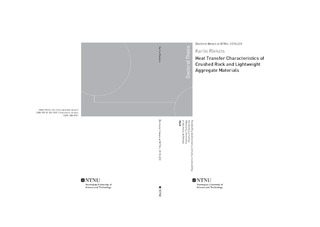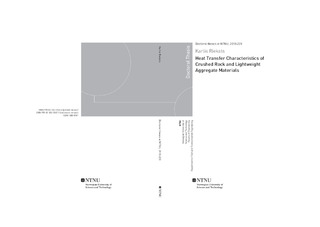| dc.contributor.advisor | Hoff, Inge | |
| dc.contributor.advisor | Scibilia, Elena | |
| dc.contributor.advisor | Côté, Jean | |
| dc.contributor.author | Rieksts, Karlis | |
| dc.date.accessioned | 2018-11-13T08:28:49Z | |
| dc.date.available | 2018-11-13T08:28:49Z | |
| dc.date.issued | 2018 | |
| dc.identifier.isbn | 978-82-326-3247-3 | |
| dc.identifier.issn | 1503-8181 | |
| dc.identifier.uri | http://hdl.handle.net/11250/2572091 | |
| dc.description.abstract | Over the last decades there has been a major transition to using crushed rock materials for road and railway construction instead of natural materials such as sand or gravel. In addition, it is common practice to use very coarse and sometimes open graded materials for structural layers. Knowledge of the thermal properties of construction materials is crucial for proper thermal design for road and railway structures. Thermal conductivity is the governing heat transfer mechanism in most such materials. However, with coarse open graded materials, natural air convection can make a significant contribution to the overall heat transfer.
This study investigates the heat-transfer characteristics of granular materials with a focus on natural air convection. It consists of three parts: i) small-scale experiments on particle thermal conductivity and crushed rock thermal conductivity, and the validation and adaptation of an existing thermal conductivity model; ii) large-scale experiments on natural convection, the establishment of intrinsic permeability and subsequent modeling of large scale experiments; iii) investigations of possible air convection under field conditions in a full-scale road structure.
The small-scale experiments showed to have good results on thermal conductivity measurements of particle thermal conductivity and thermal conductivity of crushed rock materials. For the validation and adaptation of the thermal conductivity model, 42 samples were prepared and 328 tests conducted in unfrozen and frozen states with different degrees of moisture content.
A large-scale heat transfer cell with an inner volume of 1m3 was used to measure the increase in heat transfer due to natural air convection. A method based on the analytical Nusselt (Nu)-Rayleigh (Ra) number relationship was used to establish the intrinsic permeability (K) of different construction materials. These included three crushed rock materials (20/120, 40/120 and 20/250 mm) and two lightweight aggregates: expanded clay and foam glass. The experimental results showed that natural air convection could be initiated in all three crushed rock materials at a fairly low temperature gradient (∇T) of 4.5 to 6.5° C/m. The established K for crushed rock materials ranged from 1.1 to 2.2x10-6 m2. Air convection for foam glass and expanded clay (10/20 mm) material was initiated at critical ∇T of 11.0 and 22.5°C/m respectively. The corresponding K values based on the experimental measurements were 0.86 and 0.17x10-6 m2. The overall results show that air convection can be induced at a relatively low ∇T.
To observe material characteristics under field conditions, a full-scale test site was constructed incorporating ten different sections. This study, however, focuses on only two sections, which had layers of open graded materials. Observations of the temperature profiles during the cooling period found that ∇T exceeded the critical value in all open graded layers. However, given that the air convection also depends on layer thickness, apparent Rayleigh number (Ra*) was calculated. The results show that Ra* exceeded the critical value only in a 1.0 m thick frost protection layer (40/120 mm crushed rock) and a 0.6 m thick foam glass layer (10/60 mm). To further investigate possible air convection under field conditions, a numerical model was developed. The results from the model clearly show the presence and effect of air convection. However, it could be that the effect of convection was overestimated, given that the K values were established under laboratory conditions with materials with no compaction.
To sum up, this study has shown that a simple thermal conductivity model could be adapted, with slight calibration, for the estimation of thermal conductivity in crushed rock materials. The study has also shown that natural air convection could easily be initiated in coarse materials used in road construction under relatively low temperature gradients. The study at the field test site found that layers with coarse, open graded materials are exposed to very high temperature gradients. The field observations and analysis together with the numerical model showed the possible presence of natural air convection. Air convection can have an adverse effect on seasonal freezing environments by increasing the depth of frost penetration, resulting in possible differential heaving. | nb_NO |
| dc.language.iso | eng | nb_NO |
| dc.publisher | NTNU | nb_NO |
| dc.relation.ispartofseries | Doctoral theses at NTNU;2018:228 | |
| dc.relation.haspart | Paper 1: Rieksts, K., Hoff, I., Scibilia, E. and Côté, J., 2018. Establishment of intrinsic permeability of coarse open graded materials – a review and analysis of existing data from natural air convection tests
- is not included due to copyright | nb_NO |
| dc.relation.haspart | Paper 2: Rieksts, Karlis; Hoff, Inge; Kuznetsova, Elena; Côté, Jean. Laboratory investigations of thermal properties of crushed rock materials. I: Bearing Capacity of Roads, Railways and Airfield. CRC Press 2017 ISBN 9781138295957. s. 143-149 | nb_NO |
| dc.relation.haspart | Paper 3: Rieksts, K., Hoff, I., Scibilia, E. and Côté, J., 2018. Laboratory investigations on convective heat transfer for road construction materials
- is not included due to copyright | nb_NO |
| dc.relation.haspart | Paper 4: Rieksts, K., Hoff, I., Scibilia, E. and Côté, J., 2018. Modelling the Nu-Ra relationship to establish the intrinsic permeability of coarse open graded materials from natural air convection tests in 1m3 cell.
- is not included due to copyright | nb_NO |
| dc.relation.haspart | Paper 6: Rieksts, K., Hoff, I., Scibilia, E. and Côté, J., 2018. Comparison of different methods to assess the thermal conductivity of crushed rock solid particles used for road and railway construction.
- is not included due to copyright | nb_NO |
| dc.relation.haspart | Paper 6: Rieksts, K., Hoff, I., Scibilia, E. and Côté, J., 2018. Validation and adaptation of thermal conductivity model for crushed rock materials
- is not included due to copyright | nb_NO |
| dc.relation.haspart | Paper 7: Rieksts, K., Hoff, I., Scibilia, E. and Côté, J., 2018. The presence of natural air convection in road structural layers: comparison between field observations and numerical model.
- is not included due to copyright | nb_NO |
| dc.title | Heat Transfer Characteristics of Crushed Rock and Lightweight Aggregate Materials | nb_NO |
| dc.type | Doctoral thesis | nb_NO |
| dc.subject.nsi | VDP::Technology: 500::Environmental engineering: 610 | nb_NO |

